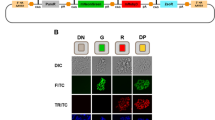Abstract
Objectives
To examine whether an autonomously replicating, artificial chromosome-like vector containing a long genomic DNA sequence (namely, Epigenosome-Nanog) undergoes de novo CpG methylation after maintenance in cultured cells for more than a half year.
Results
Epigenosome-Nanog efficiently replicated in iPS cells after transfection. In HeLa and C2C12 cells Epigenosome-Nanog was stably maintained for more than eight months. The CpG methylation occurred de novo at the Nanog gene promoter region on the epigenosome in C2C12 cells but the degrees of methylation were much lower than those at the same CpG sites on the chromosomes. Among the four CpG sites at the region, the upstream two CpGs underwent methylation in a correlated manner while methylation at the downstream two CpGs was also correlated to each other, and these correlations were commonly shared between the epigenosome and the chromosome. CpG methylation thus was not solely dependent on the nucleotide sequence at the DNA locus.
Conclusion
The epigenosome may become a useful tool to study the mechanisms of epigenetic regulation of a genetic region of interest in mammalian cells.





Similar content being viewed by others
References
Cheng X, Blumenthal RM (2008) Mammalian DNA methyltransferases: a structural perspective. Structure 16:341–350
Gao F, Kishida T, Ejima A, Gojo S, Mazda O (2013) Myostatin acts as an autocrine/paracrine negative regulator in myoblast differentiation from human induced pluripotent stem cells. Biochem Biophys Res Commun 431:309–314
Hattori N, Imao Y, Nishino K, Hattori N, Ohgane J, Yagi S, Tanaka S, Shiota K (2007) Epigenetic regulation of Nanog gene in embryonic stem and trophoblast stem cells. Genes Cells 12:387–396
Hirt B (1967) Selective extraction of polyoma DNA from infected mouse cell cultures. J Mol Biol 26:365–369
Kelleher ZT, Fu H, Livanos E, Wendelburg B, Gulino S, Vos JM (1998) Epstein-Barr-based episomal chromosomes shuttle 100 kb of self-replicating circular human DNA in mouse cells. Nat Biotechnol 16:762–768
Kishida T, Asada H, Kubo K, Sato YT, Shin-Ya M, Imanishi J, Yoshikawa K, Mazda O (2008) Pleiotrophic functions of Epstein-Barr virus nuclear antigen-1 (EBNA-1) and oriP differentially contribute to the efficiency of transfection/expression of exogenous gene in mammalian cells. J Biotechnol 133:201–207
Kishida T, Ejima A, Yamamoto K, Tanaka S, Yamamoto T, Mazda O (2016) Reprogrammed functional brown adipocytes ameliorate insulin resistance and dyslipidemia in diet-induced obesity and type 2 diabetes. Stem Cell Rep. (in press)
Li E (2002) Chromatin modification and epigenetic reprogramming in mammalian development. Nat Rev Genet 3:662–673
Marechal V, Dehee A, Chikhi-Brachet R, Piolot T, Coppey-Moisan M, Nicolas JC (1999) Mapping EBNA-1 domains involved in binding to metaphase chromosomes. J Virol 73:4385–4392
Mazda O (2002) Improvement of nonviral gene therapy by Epstein-Barr virus (EBV)-based plasmid vectors. Curr Gene Ther 2:379–392
Mazda O, Satoh E, Yasutomi K, Imanishi J (1997) Extremely efficient gene transfection into lympho-hematopoietic cell lines by Epstein-Barr virus-based vectors. J Immunol Methods 204:143–151
Nakashima H, Nakano M, Ohnishi R, Hiraoka Y, Kaneda Y, Sugino A, Masumoto H (2005) Assembly of additional heterochromatin distinct from centromere-kinetochore chromatin is required for de novo formation of human artificial chromosome. J Cell Sci 118:5885–5898
Okita K, Ichisaka T, Yamanaka S (2007) Generation of germline-competent induced pluripotent stem cells. Nature 448:313–317
Sears J, Kolman J, Wahl GM, Aiyar A (2003) Metaphase chromosome tethering is necessary for the DNA synthesis and maintenance of oriP plasmids but is insufficient for transcription activation by Epstein-Barr nuclear antigen 1. J Virol 77:11767–11780
Tomiyasu K, Satoh E, Oda Y, Nishizaki K, Kondo M, Imanishi J, Mazda O (1998) Gene transfer in vitro and in vivo with Epstein-Barr virus-based episomal vector results in markedly high transient expression in rodent cells. Biochem Biophys Res Commun 253:733–738
Wohlgemuth JG, Kang SH, Bulboaca GH, Nawotka KA, Calos MP (1996) Long-term gene expression from autonomously replicating vectors in mammalian cells. Gene Ther 3:503–512
Yamamoto K, Kishida T, Sato Y, Nishioka K, Ejima A, Fujiwara H, Kubo T, Yamamoto T, Kanamura N, Mazda O (2015) Direct conversion of human fibroblasts into functional osteoblasts by defined factors. Proc Natl Acad Sci USA 112:6152–6157
Acknowledgments
The present study was supported by grants from the Japan Science and Technology Agency, and the Japanese Ministry of Education, Culture, Sports, Science and Technology.
Supporting information
Supplementary Fig. 1 – Successful construction of the Epigenosome-Nanog.
Author information
Authors and Affiliations
Corresponding author
Ethics declarations
Conflict of interest
The authors declare no conflict of interest.
Electronic supplementary material
Below is the link to the electronic supplementary material.
Rights and permissions
About this article
Cite this article
Nishioka, K., Kishida, T., Masui, S. et al. De novo CpG methylation on an artificial chromosome-like vector maintained for a long-term in mammalian cells. Biotechnol Lett 38, 731–740 (2016). https://doi.org/10.1007/s10529-015-2029-4
Received:
Accepted:
Published:
Issue Date:
DOI: https://doi.org/10.1007/s10529-015-2029-4




